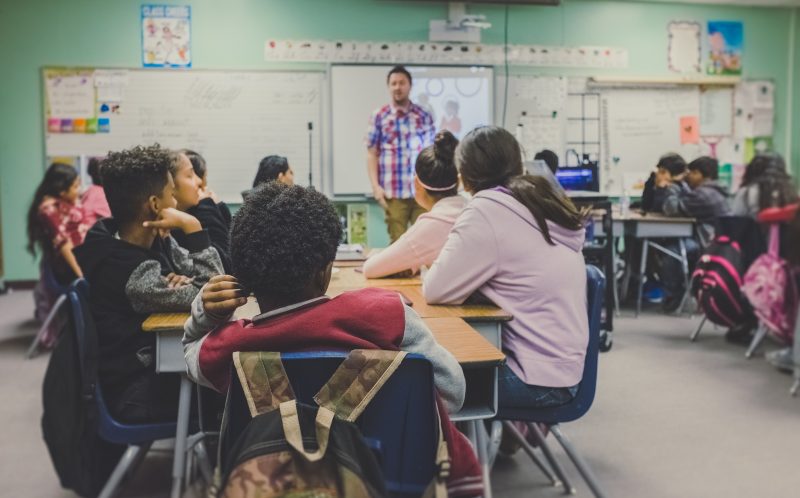7 Ways to Make Your Teaching Less Racist
Posted on November 14, 2019
In 2015, I was working in a school in the West Side of Chicago. Of the 300-some students at our school, 95.8% of them were Black. 0.0% of them were White. Yet, in our K-8 school, there was only one Black teacher. Black people were at our school in roles of security guards, lunch staff, teacher assistants etc. but when it came to the teachers and school leadership, the staff was 95% White.
This is a common occurrence. According to the National Center for Education Statistics, in 2015-2016 80% of public school teachers in the United States were white. There is a wealth of research that demonstrates the benefits from having people-of-color teachers. In one such study by John Hopkins University, it was shown that having at least one black teacher in third through fifth grades reduced a black student’s probability of dropping out of school by 29 percent. For very low-income black boys, the results are even greater; their chance of dropping out fell 39 percent (1).
In an ideal world, our teachers would be more diverse and represent the communities they serve. But until that happens, we can improve educational outcomes for non-white students by teaching white teachers to be less racist. More race-conscious?
Teaching is an art. Inspired by “7 Things You Can Do To Make Your Art Less Racist”, I propose a list of 7 things a white teacher can do to make their teaching less racist.
- Understand the role of power— Being a teacher in a classroom is already setting up a power dynamic. Being a White teacher to a classroom of non-White students is another power dynamic. Find ways to shift the power. Treat students with kindness and respect, and less as an authority figure. Get eye-level with the students instead of always standing/towering above them. Have students take turns leading parts of class. Help students feel agency over their education.
- Be open minded– You have as much to learn from the students as they do from you. Value their life experiences like you value textbooks as a source of knowledge.
- Understand students as a product of the system – Black students are more likely to get suspended than White students. Just because a student is acting up doesn’t mean they’re bad. What factors are contributing to this behavior? When addressing behavior, consider the whole child and not just the incident. A little empathy can go a long way.
- Create a non-punitive behavior management – The school-to-prison pipeline is where children are funneled out of public school and into the criminal justice system. It starts with the way behavior is managed in schools. Alexander Reynoldssaid it best: “The phenomenon manifests itself in disciplinary practices and zero-tolerance policies that criminalize unruly behavior and minor infractions such as truancy, graffiti or violating a school dress code.” If your school is employing these techniques, advocate for your students. Use restorative justice techniques instead of punitive.
- Lean into conflict- If somebody says something prejudiced, don’t sweep it under the rug. Address it. And if somebody says you said something prejudiced or racist, hear their truth. Their truth is more important than your intent.
- Diversify the curriculum. When teaching history, whose history are you teaching? What voices are missing? Expose kids to a wide selection of voices and perspectives. As said by Africa Arena Mills, a Black Educator Mom, “my children’s school experiences would have been far more valuable if you would have introduced them to the lives and works of Ellen and William Craft, Katherine Johnson, Lewis Hayden, Ida B. Wells and Denmark Vesey. They wanted to hear you tell them the truth about The Black Panther Party, the reasons behind the FBI’s surveillance of Martin Luther King, Jr., the painful facts about Columbus’s experiences in the Americas, and the meaning of Juneteenth. And they [don’t] want to just hear a few tidbits about these essential and complex aspects of American life in February just because it was Black History Month.”
- Name your Whiteness – As said by veteran teacher Zachary Wright, “ As a White male teacher, whose goals are to not only teach, but also learn from my students, I need to be aware of, and need to name, the privilege that inevitably blinds me from truly understanding what it means to be Black in America. Standing in front of my classroom of Brown and Black children, teaching texts like “Beloved and The New Jim Crow,” I need to name the loaded reality that a White man is teaching an experience that is not his own.” Have real and raw conversations about race in the classroom. Acknowledge that you are White and that that comes with privilege. Recognize that you don’t share the experiences of non-White students in America and give students space to share their lived experiences.
Disclaimer: My personal experience in the classroom is very limited. This list is based on suggestions from more seasoned professionals along with opinions of my own.
SR
Bibliography
Chandler-Ward, Jenna. 2019. “Teaching While White.” Teaching While White. June 24, 2019. https://teachingwhilewhite.org/blog/2019/6/21/a-letter-to-white-teachers-of-my-black-children.
Fay, Laura. 2019. “What’s the Racial Breakdown of America’s Public School Teachers?” The74million.Org. 2019. https://www.the74million.org/article/whats-the-racial-breakdown-of-americas-public-school-teachers/.
“I’m a White Male Teacher Teaching Black Kids and We Have to Talk About That.” 2017. Education Post. October 27, 2017. https://educationpost.org/im-a-white-male-teacher-teaching-black-kids-and-we-have-to-talk-about-that/.
“Op-Ed: White Teachers Need to Check Their Racism Before Teaching It.” 2018. Usc.Edu. 2018. https://rossieronline.usc.edu/youth-and-racism/akiea-gross-op-ed.
Reynolds, Alexander. 2015. “The School-to-Prison Pipeline Is Institutional Racism.” HuffPost. HuffPost. September 9, 2015. https://www.huffpost.com/entry/school-to-prison_b_8108068.
The Mic Movement. 2013. “7 Things You Can Do To Make Your Art Less Racist – A Comprehensive How-To-Guide.” The Mic Movement. February 20, 2013. https://micmovement.com/2013/02/7-things-you-can-do-to-make-your-art-less-racist-a-comprehensive-how-to-guide/.
“What’s Wrong with White Teachers?” 2017. The Hechinger Report. May 2017. https://hechingerreport.org/whats-wrong-white-teachers/.
“With Just One Black Teacher, Black Students More Likely to Graduate « News from The Johns Hopkins University.” 2017. Jhu.Edu. Johns Hopkins University. 2017. https://releases.jhu.edu/2017/04/05/with-just-one-black-teacher-black-students-more-likely-to-graduate/.